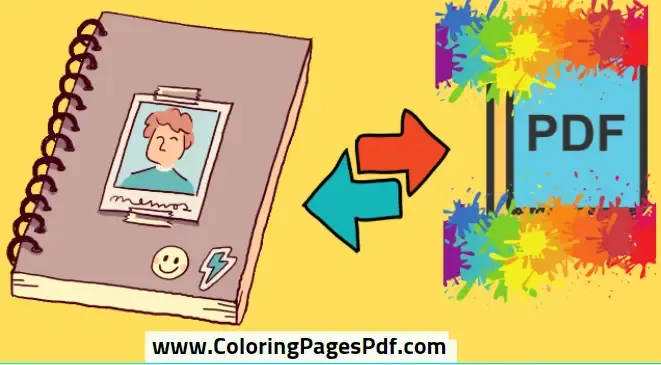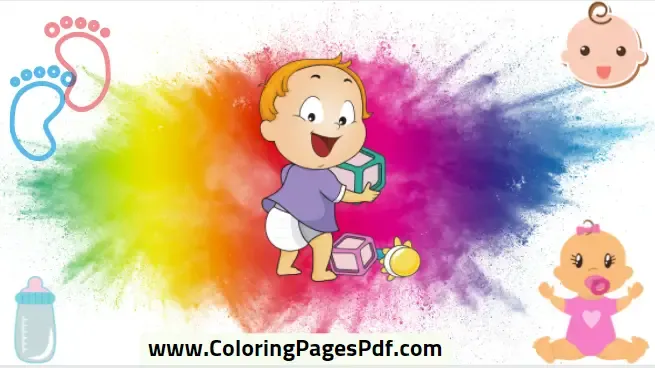1. Coloring Books For Your Baby
Coloring books are a simple and effective technique to keep your infant occupied and pleased. In their spare time, the majority of children like coloring.
Coloring is a fun hobby that your child may utilize as a learning tool. Coloring books allow you to educate your children in a fun way, ensuring that your child does not become bored while learning.
You no longer need to visit a local store and spend hours looking for a coloring book that your child would enjoy.
Various websites offer a variety of free printable coloring pages and books. Simply type your selected pages into a search engine, and hundreds of coloring books and pages will appear in a single click.
You can do so based on your child's preferences. If you want to teach your infant numbers, for example, look for a kids' math coloring book and various books for your infant.
Coloring allows children to express their creativity while also helping them to enhance their color coordination abilities. As a result, you should think about a few things before buying a coloring book for your child.
The book you chose for your baby should have a theme, and your infant should be interested in this theme. It should also be inspiring to your baby.
If your child enjoys superheroes, choose a theme based on them, such as Spiderman, He-Man, and so on. If your child enjoys dolls, choose some coloring books with a Barbie or princess theme.
Animals, vehicles, sports, fruits, vegetables, holidays, religions, numerals, alphabets, and many other characters are available.
2. Simplicity Of Coloring Books For Your Baby
Select a coloring book that corresponds to your baby's developmental stage. Some coloring pages contain a huge space for drawing the same colored picture, while others feature dotted lines.
Some people have given instructions on how to draw that artwork. As a result, you should choose a book that is appropriate for your baby's level of efficiency.
If your child is young, look for books with a lot of space for coloring. Select a dotted line book as he grows older, and when some time has passed, when his coloring abilities have improved, you can select a book with written drawing tips.
When children make a color drawing, their imaginations are sparked. You can tell if he likes or dislikes certain colors if you're a parent or a teacher.
Coloring books assist youngsters in the development of various skills such as endurance, concentration, and attention.
It allows kids to communicate their ideas and feelings in their daily lives by using colors, crayons, and papers to portray their hidden desires and innermost feelings.
3. Turn Your Photos Into A Coloring Book
Making coloring books can be a one-time effort, a continuous classroom learning tool, or a lucrative business venture. Here are some pointers to get you started.
Choose a theme For Your Coloring Book
There are, of course, a variety of options available. You can make an entire book out of only family members, the children themselves, animals, a recent trip to the circus, or anything else you may think of. Choose a topic that will appeal to the children and that they will enjoy coloring.
You may even turn this into a learning opportunity by having them recreate the first Thanksgiving or anything similar. Here, the sky is the limit. You might even discover that you have a gift for coloring book ideas that you can use to start your own company!
Choose Your Images For Your Coloring Book
Begin collecting images once you've settled on your subject. You can either print them out or use the digital photos, depending on how you want to transform them into black and white coloring book illustrations.
Choose photographs that you believe the children will connect with and appreciate the best, as well as those that will be relatively easy to convert into outlines while being recognizable. Choose pictures with simple backgrounds and textures.
If you've chosen a recent trip as your subject, make sure you have a decent timeline of events and that the youngster will enjoy recalling them.
You can start thinking about how lengthy you want the coloring book to be while you're choosing the photos. Unless you have a larger project in mind, fifteen to twenty pages are generally the most you want to undertake.
Creating Coloring Images For Your Coloring Book
If you're using a computer to create the photographs, scan them and then transfer them into a picture editing tool like Photoshop or something similar.
To obtain the photographs as near to outline form as possible, convert the image to black and white and tweak the brightness and contrast.
"Find edges" should be an option in your software. If that's the case, utilize it to assist make the snapshot look more like a pencil sketch.
This is a stage of the project that will necessitate some trial and error. More in-depth lessons may be available online or in the user manual for your software.
If you want to do this section of the project without using a computer, all you need is some tracing paper and pencils. To avoid leaving indentations on the original images, you may want to make copies.
Make sure your work area is sufficiently lit, or invest in a lighting box to aid precision. When you're done, use a felt tip pen to darken the lines and scan the picture into your computer.
Binding
There are a few choices available here. You can use a booklet maker or stapler for saddle stitching, or you may use a more permanent and durable option like a plastic comb or spiral coil binding.
You can acquire these machines for a reasonable price, and they are simple to operate, so if you plan on generating a lot of coloring books (or any other types of books) now or in the future, you might want to consider investing in your own binding system to save money.
4. How To Look For Baby Books
Seek out Books! The books you choose to read with your child are extremely important... If you're not sure what books are appropriate for your youngster, see a librarian. to assist you in selecting titles ... your
Seek out Books! The books you choose to read with your child are extremely essential. If you're not sure what books are appropriate for your child, ask a librarian for assistance.
When your child is a baby, begin exposing him or her to literature. Allow her/him to hold and play with books designed specifically for babies, such as board books with sturdy cardboard covers and dense pages; soft and washable cloth books, touch-and-feel books, or lift-the-flap books with surprises for your baby to discover.
Choose books with large, uncomplicated illustrations of things she sees every day on the covers.
Don't be alarmed if your youngster eats or throws a book at first. Be \spatient. Cuddling with the youngster while pointing to and talking about the book's pictures can quickly pique her interest. When your baby is a toddler, she will enjoy assisting you in selecting books to read to her.
You and your kid can look for books with longer stories and more words on the pages as your kid grows into a preschooler and kindergartner.
Look for books with repeated words and phrases that she can start reading or identify when she sees them. Add some books geared for beginning readers to the mix by early first grade, including some books with chapters and others without.
Add some books for beginning readers to the mix by early first grade, containing some books with chapters and others with no chapters. Rather than providing false information, present images and provide accurate information imaginative stories
Keep in mind that young children like novels about people, places, and objects that are similar to those they are familiar with.
The books can be about your hometown or aspects of your culture, such as your religion, holidays, or fashion sense. Look for books concerning your child's unique interests, such as dinosaurs or ballerinas, if he or she has any.
You should also look for books of poems and rhymes for your child from the time he or she is a toddler through the beginning of first grade.
Remember how your baby tried to replicate your talking noises when he or she was a baby? Rhymes are a natural extension of that ability.
Your child learns about spoken sounds and words by hearing and saying rhymes, as well as repeating words and phrases. Rhymes can also pique a child's interest.
Your youngster will learn about spoken sounds and words by hearing and pronouncing rhymes, as well as repeating words and phrases.
Rhymes also pique a child's interest in what follows next. Free Web Content that makes reading more enjoyable and adventurous.






Comments
Post a Comment